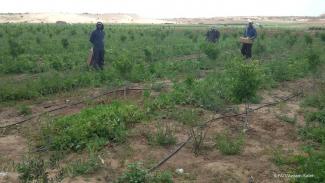Amidst ongoing access restrictions and insecurity, and despite significant damage sustained during the 2014 July-August hostilities, Palestinian farmers in the Bedouin village of Um an Naser in northern Gaza managed to complete a successful harvest. This was possible, to a large extent, due to sustained support by humanitarian and development agencies and donors, led by the UN Food and Agriculture Organization (FAO).
The Monthly Humanitarian Bulletin | May 2015
Over 12,500 housing units totally destroyed and nearly 6,500 severely damaged in the Gaza Strip during the 2014 summer hostilities, according to latest damage assessments. Concern over the precarious living conditions of approximately 100,000 internally displaced persons, particularly of those belonging to vulnerable groups. Successful spring season harvest in a restricted area in northern Gaza, following rehabilitation interventions. The Israeli army resumed military training exercises in the northern Jordan Valley, leading to the temporary displacement of four herding communities.










